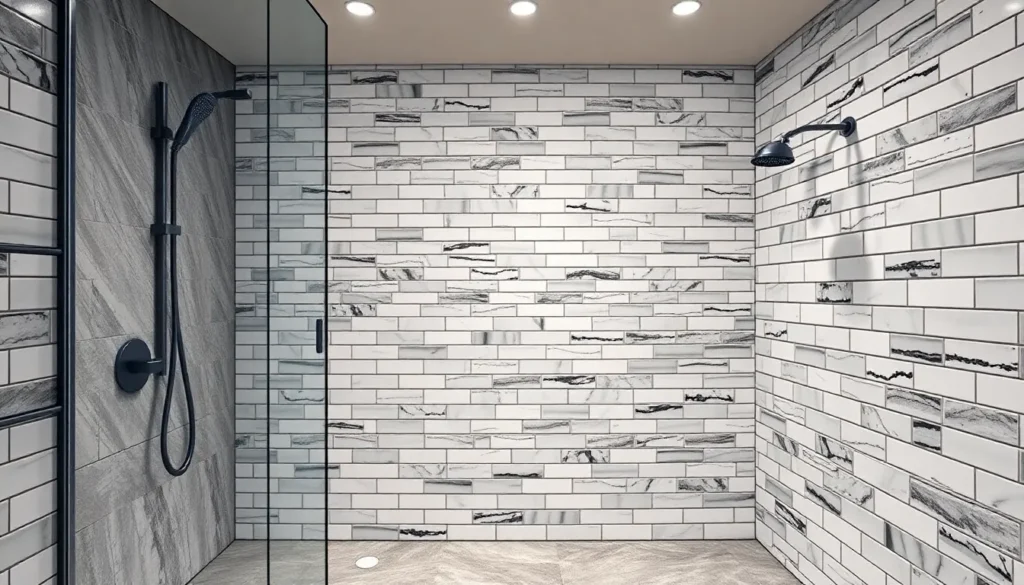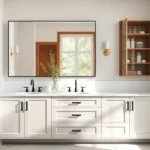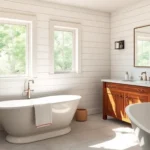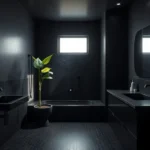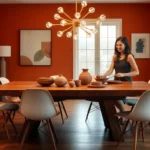We all know that choosing the right shower tiles can completely transform your bathroom from ordinary to extraordinary. Whether you’re planning a complete renovation or just looking to refresh your current space, the tile options available today offer endless possibilities for creating your dream shower.
Modern bathroom design trends are embracing everything from sleek subway tiles to bold geometric patterns, and we’re here to help you navigate through the most popular and practical choices. The right tiles don’t just look amazing – they also need to withstand daily moisture, provide proper grip, and complement your overall bathroom aesthetic.
From budget-friendly ceramic options to luxurious natural stone, we’ll explore tile ideas that work for every style and budget. You’ll discover how different materials, colors, and layouts can create stunning visual effects while ensuring your shower remains functional and easy to maintain for years to come.
Classic Subway Tile Designs for Timeless Appeal
Subway tiles remain one of our most recommended choices for shower installations because they offer versatility and enduring style. These rectangular tiles create clean lines that work beautifully in both traditional and contemporary bathroom designs.
Traditional White Subway Tiles with Dark Grout
White subway tiles paired with dark grout create striking visual contrast that emphasizes the tile pattern. We see this combination work exceptionally well in master bathrooms where homeowners want a sophisticated look without overwhelming the space. Black or charcoal gray grout lines help define each tile while adding depth to white walls.
Professional installers often recommend 3×6 inch white ceramic subway tiles for their affordability and ease of maintenance. These tiles typically cost between $0.50 to $2.00 per square foot, making them budget friendly for larger shower areas. Dark grout also hides soap scum and mineral deposits better than light colored alternatives.
The contrast effect works particularly well when we install white subway tiles in a traditional brick pattern. This layout creates horizontal lines that can make narrow shower stalls appear wider while maintaining the classic subway aesthetic.
Colored Subway Tiles for Modern Twist
Colored subway tiles offer contemporary appeal while maintaining the familiar rectangular shape we love. Sage green, navy blue, and soft pink subway tiles have become increasingly popular choices for homeowners seeking personality in their shower designs. These colors work beautifully as accent walls or full shower surrounds.
We recommend using colored subway tiles in 4×8 inch or 3×12 inch formats to create more dramatic visual impact. Larger tiles reduce grout lines and create sleeker appearances that complement modern fixtures and hardware. Glossy finishes on colored subway tiles reflect light effectively, which helps smaller bathrooms feel more spacious.
Neutral colored subway tiles like light gray or beige provide subtle variation from traditional white while remaining timeless. These shades pair well with both warm and cool color palettes, giving homeowners flexibility in their overall bathroom design scheme.
Herringbone Pattern Subway Tile Installation
Herringbone patterns transform standard subway tiles into eye catching focal points that add texture and movement to shower walls. We install subway tiles at 45 degree angles to create the distinctive zigzag pattern that draws attention upward, making shower areas appear taller.
This installation technique works best with smaller subway tiles, typically 2×4 inch or 3×6 inch sizes, because larger tiles become difficult to manage in the herringbone layout. Professional installation is often necessary since the pattern requires precise measurements and cutting around fixtures.
Herringbone subway tile patterns create premium appearances that increase perceived value in bathroom renovations. The installation typically costs 15 to 25 percent more than traditional brick patterns due to increased labor time and tile waste. But, the sophisticated result justifies the additional investment for many homeowners seeking distinctive shower designs.
Natural Stone Tile Options for Luxury Feel
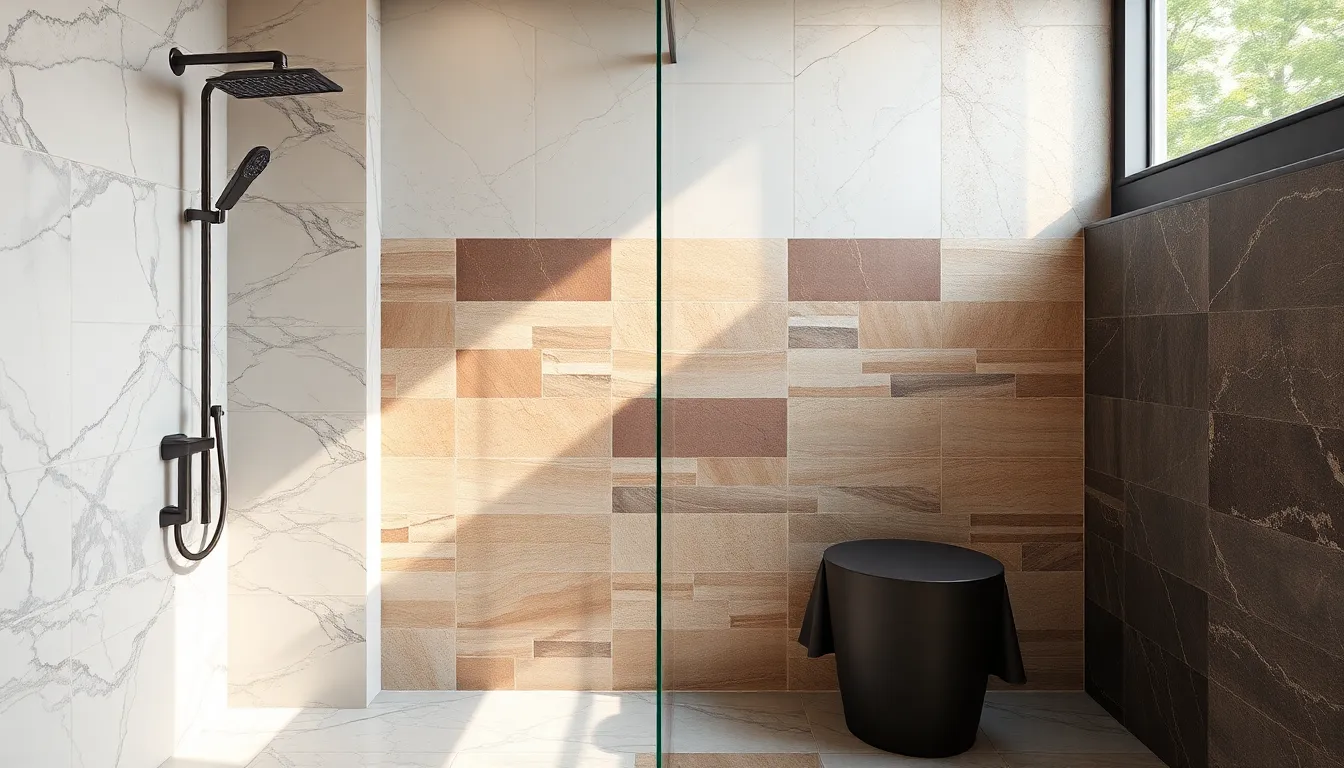
We recommend natural stone tiles when you’re ready to elevate your shower design beyond traditional ceramic options. These premium materials offer unmatched durability and aesthetic appeal that transforms ordinary bathrooms into spa-like retreats.
Marble Tiles for Elegant Sophistication
Marble tiles deliver the ultimate luxury experience with their distinctive veining patterns and timeless elegance. We’ve seen these sophisticated tiles add important value to master bathroom renovations due to their high-end appearance and classic appeal. Popular varieties include Carrara marble with its subtle gray veining and Calacatta marble featuring bold, dramatic patterns.
Available shades range from pure white to deep blacks and warm beiges, giving you flexibility to match any design scheme. Installation costs typically run higher than ceramic alternatives, but the investment pays dividends through increased home value and lasting beauty. We suggest using larger format marble tiles to minimize grout lines and create a more seamless, luxurious appearance.
Travertine Tiles for Rustic Charm
Travertine tiles bring natural texture and earthy warmth to shower spaces through their distinctive porous surface and neutral color palette. These tiles excel at creating inviting atmospheres with their rustic charm and organic appearance. Color options include cream, beige, gold, and light brown tones that complement both traditional and transitional bathroom styles.
Tumbled travertine offers a weathered, aged look while honed varieties provide smoother surfaces with subtle texture. We recommend filled travertine for shower applications to prevent water and soap buildup in the natural holes. The material’s slip-resistant properties make it practical for wet areas while maintaining its decorative appeal.
Slate Tiles for Contemporary Style
Slate tiles provide the perfect foundation for modern, minimalist bathroom designs with their sleek dark appearance and contemporary aesthetic. We appreciate how these tiles create sophisticated focal points through their rich color variations and natural cleft textures. Available colors include charcoal gray, deep black, and subtle blue-gray tones that work beautifully in modern shower surrounds.
Cleft surface slate offers excellent slip resistance for safety while maintaining its stylish appearance. Gauged slate provides more uniform thickness for easier installation and cleaner lines. We suggest pairing slate with lighter colored accent tiles or fixtures to create striking visual contrast in contemporary shower designs.
Mosaic Tile Patterns for Visual Interest
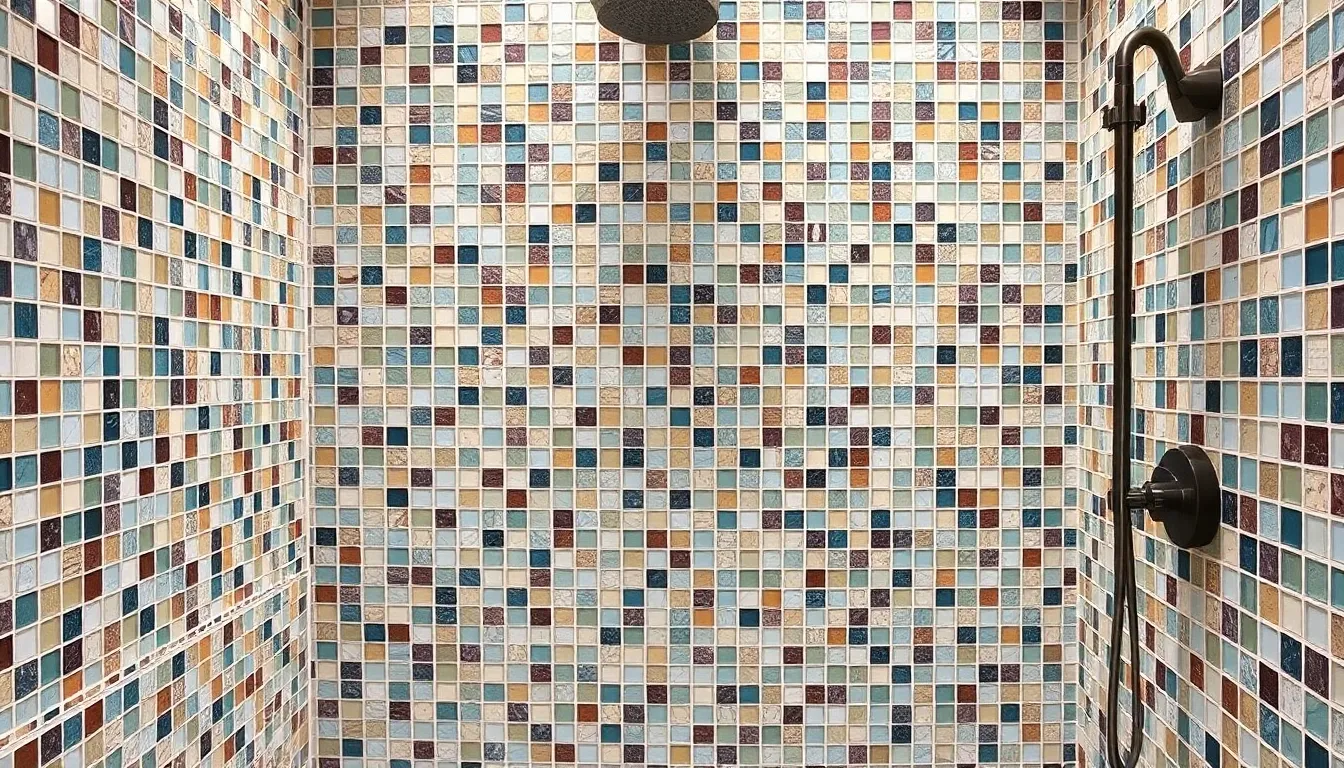
Mosaic tiles transform ordinary shower spaces into stunning visual displays through intricate patterns and diverse material combinations. We’ll explore how these versatile tiles can create customized designs that enhance both compact and expansive bathroom areas.
Glass Mosaic Tiles for Light Reflection
Glass mosaic tiles excel at reflecting light throughout your shower space, creating a brighter and more spacious atmosphere. These reflective surfaces work particularly well in smaller bathrooms where amplifying the sense of openness becomes crucial for design success.
Available in countless colors and finishes, glass tiles offer seamless transitions between different bathroom zones. We recommend using lighter shades like clear, white, or pale blue to maximize light reflection and create an airy feel.
Installation patterns can vary from simple grid layouts to complex geometric designs. Consider using different sized glass tiles within the same color family to add depth without overwhelming the space.
Stone Mosaic Combinations for Texture
Stone mosaic tiles introduce natural textures that add warmth and depth to shower environments. We combine materials like marble, slate, and travertine to create unique surface variations that enhance visual appeal through organic patterns.
Marble mosaics bring luxury and sophistication with their distinctive veining patterns. Travertine options provide rustic charm through their naturally pitted surfaces, while slate delivers contemporary elegance with smooth, refined textures.
Mixing different stone types within a single design creates ever-changing contrast. We suggest pairing polished marble with honed slate or combining rough travertine with smooth granite for striking textural variety.
Mixed Material Mosaic Designs
Mixed material mosaics combine glass, stone, and ceramic elements to achieve personalized shower designs with unlimited creative possibilities. These combinations balance texture, color, and visual interest while creating truly distinctive spaces.
Pairing glass tiles with natural stone creates stunning contrast between reflective and matte surfaces. We recommend using 70% stone and 30% glass for optimal balance, or reversing these proportions for brighter, more contemporary looks.
Ceramic elements add durability and color variety to mixed material designs. Consider incorporating metallic accents through stainless steel or copper tiles to introduce modern industrial elements into your mosaic pattern.
Large Format Tiles for Seamless Look
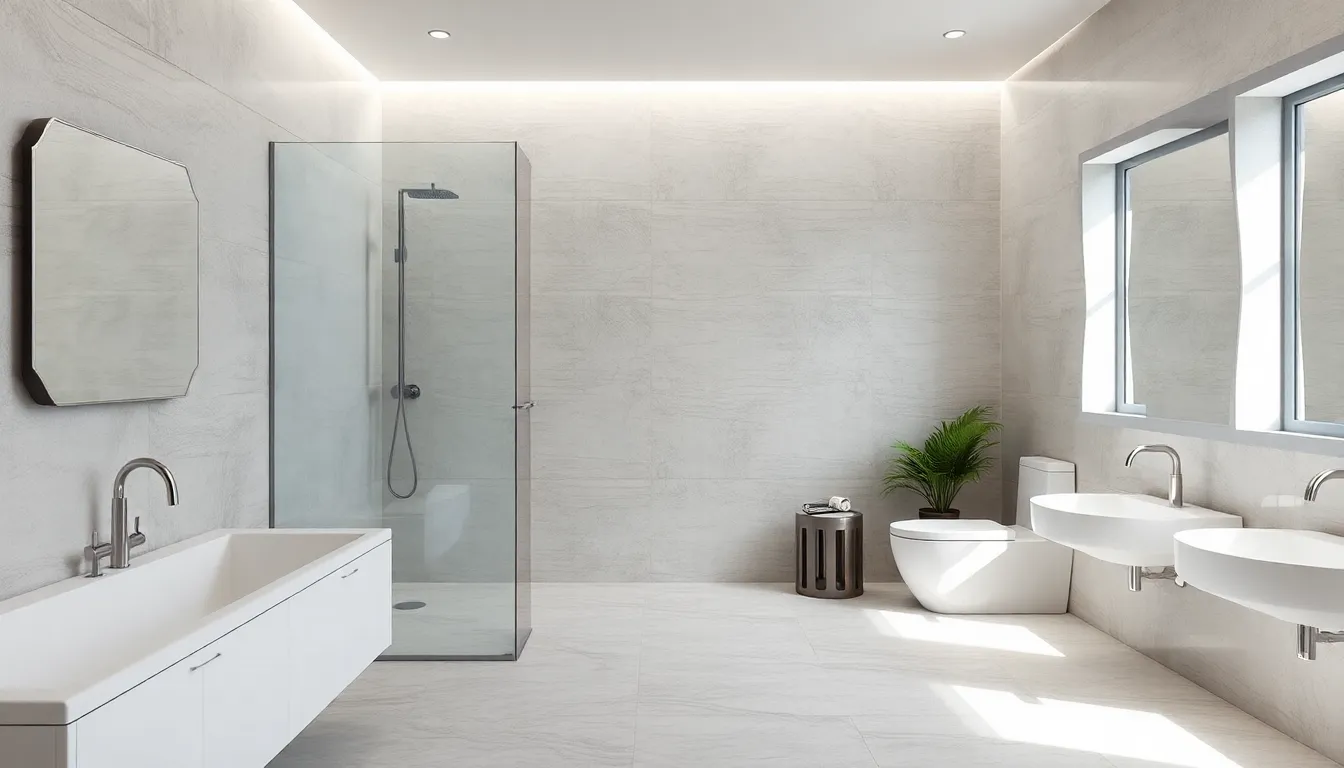
Moving beyond traditional tile sizes, we find that large format tiles measuring 12×24 inches or larger create a sophisticated, uninterrupted appearance that transforms any shower space. These expansive tiles reduce visual clutter by minimizing grout lines, making bathrooms feel more spacious and luxurious.
Porcelain Slab Installation Benefits
Porcelain slabs offer exceptional durability and visual appeal that’s revolutionizing bathroom design. These continuous pieces can mimic natural stone or concrete while providing a high-end look without the maintenance issues of natural materials. We’ve seen increasing popularity in porcelain slab installations because they create sophisticated appearances with minimal seams. Installation becomes more streamlined since fewer individual pieces are needed, and the reduced grout requirements make cleaning significantly easier.
Minimalist Design with Fewer Grout Lines
Fewer grout lines enhance visual flow throughout the bathroom, creating a sense of continuity that feels both elegant and modern. We recommend matching tile color to grout color for the most seamless appearance, making the entire surface appear as one cohesive unit. This design approach works particularly well in contemporary bathrooms where clean lines and uncluttered surfaces are priorities. Large format tiles in materials like porcelain, marble, and terrazzo provide the foundation for this minimalist aesthetic.
Easy Maintenance and Cleaning Advantages
Maintenance becomes significantly easier with large format tiles, especially in high-moisture shower environments. We’ve found that fewer grout lines mean less opportunity for mold and mildew accumulation, making regular cleaning more efficient and effective. Porcelain and ceramic materials naturally resist water penetration, further reducing maintenance needs over time. Daily cleaning requires less scrubbing since there are fewer grout lines to target, and the smooth surfaces of large format tiles prevent soap scum buildup more effectively than smaller tiles with multiple grout intersections.
Textured Tile Surfaces for Safety and Style
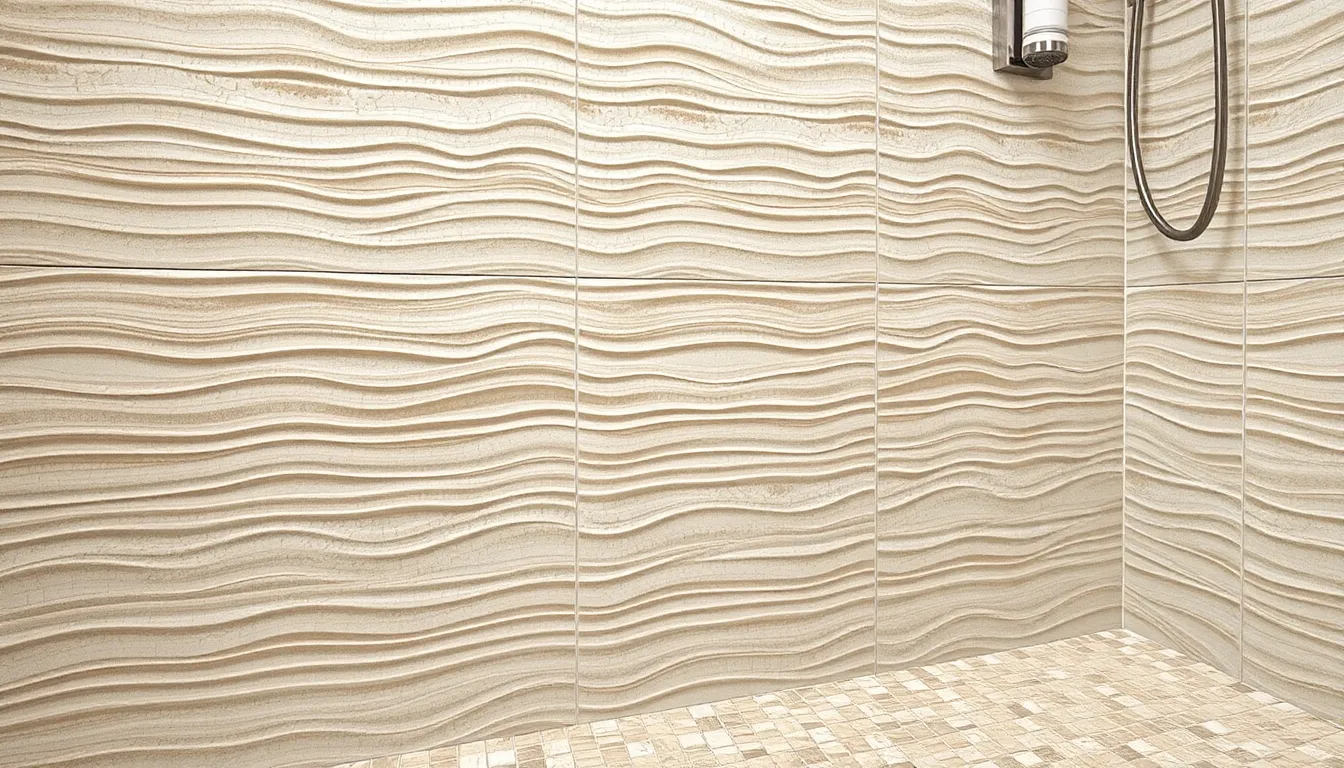
Textured tiles combine practical safety features with sophisticated design elements, making them an essential consideration for any shower renovation. These surfaces provide the grip you need while maintaining the aesthetic appeal that transforms your bathroom into a luxurious retreat.
3D Wall Tiles for Dimensional Appeal
Three dimensional wall tiles create stunning visual depth that transforms flat shower walls into architectural statements. These tiles cast shadows and catch light in ways that add drama and sophistication to your shower space. Wave patterns, geometric designs, and organic shapes offer endless possibilities for customizing your bathroom’s personality.
Installing 3D tiles on accent walls maximizes their impact without overwhelming the space. Focus on the wall opposite your shower entrance or behind the shower head to create a natural focal point. Neutral colors like white, gray, or beige work best for these statement pieces, as they allow the texture to shine without competing with other design elements.
Consider the scale of your shower when selecting 3D tile patterns. Larger bathrooms can handle bold, oversized textures, while smaller spaces benefit from subtle relief patterns that add interest without making the area feel cramped.
Non-Slip Floor Tile Options
Mosaic tiles excel at preventing slips thanks to their many grout lines that create natural traction points throughout your shower floor. The small format pieces conform to shower pan slopes better than larger tiles, ensuring proper water drainage while maintaining safety. Glass, ceramic, and stone mosaic options all provide excellent grip when wet.
Checkerboard patterns using contrasting colors create visual interest while maintaining safety standards. Black and white combinations remain classic choices, though earth tones and muted colors offer more contemporary alternatives. The alternating pattern helps define spaces and adds personality to your shower floor.
Herringbone layouts using small format tiles maximize slip resistance through their angular installation pattern. This traditional pattern works exceptionally well with natural stone tiles like travertine or slate, combining safety with timeless style. The zigzag design creates multiple grip points that enhance traction from every angle.
Penny tiles, typically measuring one inch in diameter, offer maximum grout coverage for superior slip resistance. Their vintage appeal pairs beautifully with subway wall tiles, creating cohesive design schemes that balance safety with style.
Tactile Surfaces for Sensory Experience
Natural stone textures provide rich sensory experiences that connect you with organic materials during your daily routine. Rough cut travertine, tumbled marble, and honed slate each offer unique tactile qualities that enhance the shower experience beyond visual appeal. These surfaces feel substantial underfoot and provide interesting texture variations throughout your shower space.
Brushed finishes on ceramic and porcelain tiles create subtle texture that feels smooth yet provides adequate grip. These surfaces offer the best of both worlds – refined appearance with practical functionality. Brushed tiles work particularly well in contemporary designs where clean lines meet practical requirements.
Ribbed or fluted tile surfaces add linear texture that guides water flow while creating interesting shadow patterns. These designs work especially well on shower floors where the linear grooves help channel water toward drains. Vertical ribbing on walls can make ceilings appear higher, while horizontal patterns emphasize width.
Mixed texture combinations using smooth and textured tiles in the same space create ever-changing contrast that engages multiple senses. Pair glossy subway tiles with matte textured accents, or combine smooth large format tiles with rough natural stone borders for sophisticated layering effects.
Bold Color and Pattern Combinations
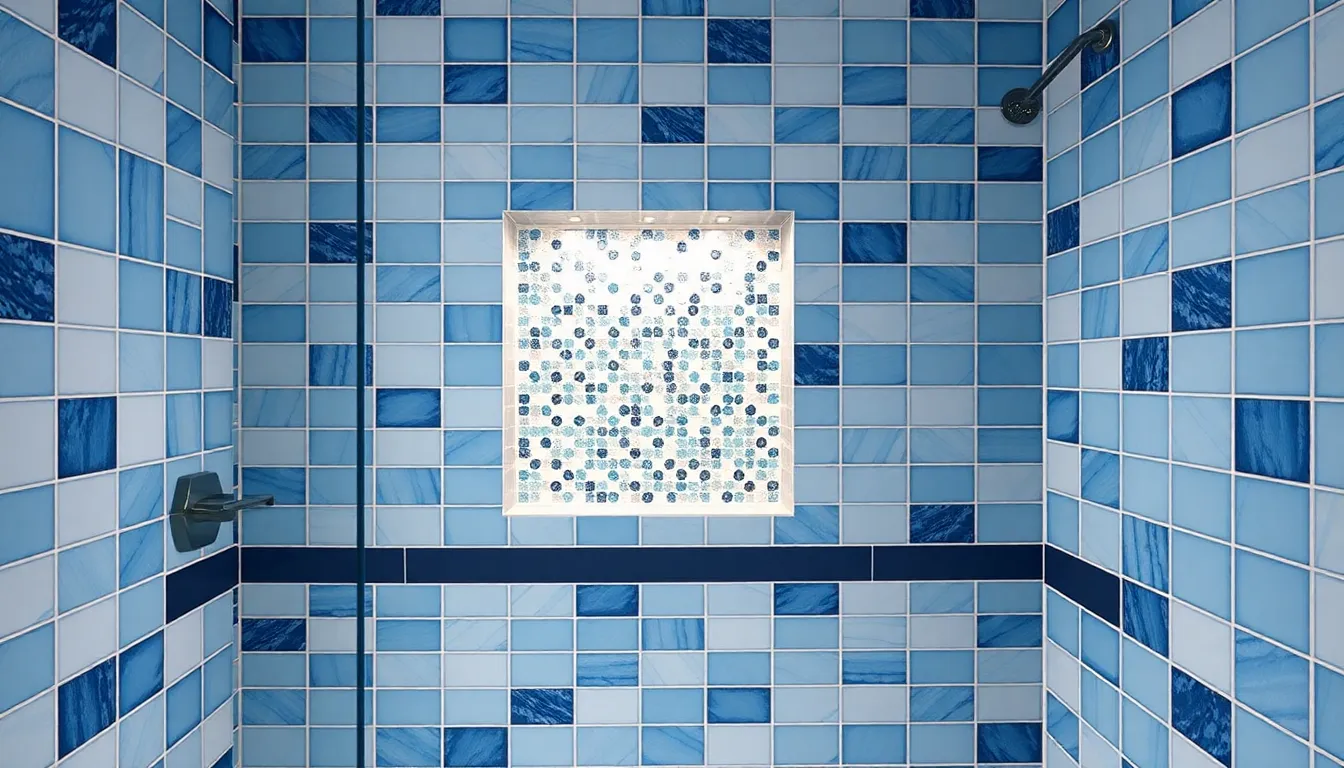
Bold color and pattern combinations elevate shower spaces from functional to extraordinary. These design approaches transform ordinary bathrooms into personalized retreats that reflect individual style preferences.
Geometric Tile Arrangements
Herringbone patterns create ever-changing visual movement while maintaining sophisticated elegance. We recommend using rectangular or subway tiles in this arrangement to achieve the perfect balance between modern innovation and traditional aesthetics. Installing herringbone patterns requires precise measurement and cutting, but the results justify the additional effort.
Chevron arrangements offer a contemporary alternative that draws the eye upward and creates perceived height in smaller shower spaces. Mosaic tiles work exceptionally well in chevron patterns, providing both visual interest and enhanced safety through increased grout lines. These installations require skilled craftsmanship to ensure proper alignment and consistent spacing.
Checkerboard patterns deliver timeless appeal with Moroccan-inspired designs that use contrasting colors or shapes. Alternating black and white tiles create classic drama, while navy and cream combinations provide sophisticated warmth. Grid arrangements using square tiles offer clean lines that complement minimalist bathroom designs.
Mosaic geometric accents serve as stunning focal points when installed on feature walls or shower niches. These intricate patterns combine multiple tile shapes and sizes to create complex visual textures. Border installations using geometric mosaics frame shower spaces beautifully while maintaining practical functionality.
Contrasting Color Schemes
Dark and light pairings produce striking graphic effects that command attention. We suggest pairing white subway tiles with charcoal or black grout to create bold definition between each tile. This combination highlights the tile’s shape while adding contemporary edge to classic designs.
Color blocking techniques use navy and white or emerald green and gray combinations to create distinct zones within shower spaces. These approaches work particularly well when one color dominates the walls while the contrasting shade appears in accent strips or niches. Terracotta and cream pairings bring warmth and earthiness to bathroom environments.
Grout color contrast transforms ordinary tile installations into extraordinary design statements. Light tiles with dark grout emphasize individual tile shapes, while dark tiles with light grout create softer, more unified appearances. This simple technique costs minimal additional expense but delivers maximum visual impact.
Texture contrast combinations pair smooth glossy tiles with matte finishes to create sophisticated depth. Mixing ceramic wall tiles with natural stone accents provides both visual and tactile interest. These combinations work especially well when the textures complement rather than compete with each other.
Accent Wall Feature Designs
Tiled shower niches serve dual purposes as functional storage and decorative focal points. We recommend using bold colors or unique patterns in these recessed areas to create visual interest without overwhelming the entire shower space. Mosaic tiles work particularly well in niches because their smaller scale suits the proportions perfectly.
Feature wall installations draw attention through strategic placement of contrasting materials or dramatic patterns. These walls often incorporate geometric mosaics or vibrant color combinations that stand out against neutral surrounding tiles. Installing feature walls behind the shower head or opposite the entrance maximizes their visual impact.
Illuminated accent walls combine decorative tiling with strategic lighting to create stunning nighttime effects. LED strip lighting installed behind translucent tiles or within recessed niches highlights the tile’s texture and color. These installations require careful planning during the rough-in phase but deliver exceptional results.
Border and frame designs use contrasting tiles to create defined edges around shower spaces or exact areas. Mosaic borders can separate different tile zones while maintaining visual continuity. These design elements help organize larger shower spaces into distinct functional areas.
Budget-Friendly Tile Alternatives
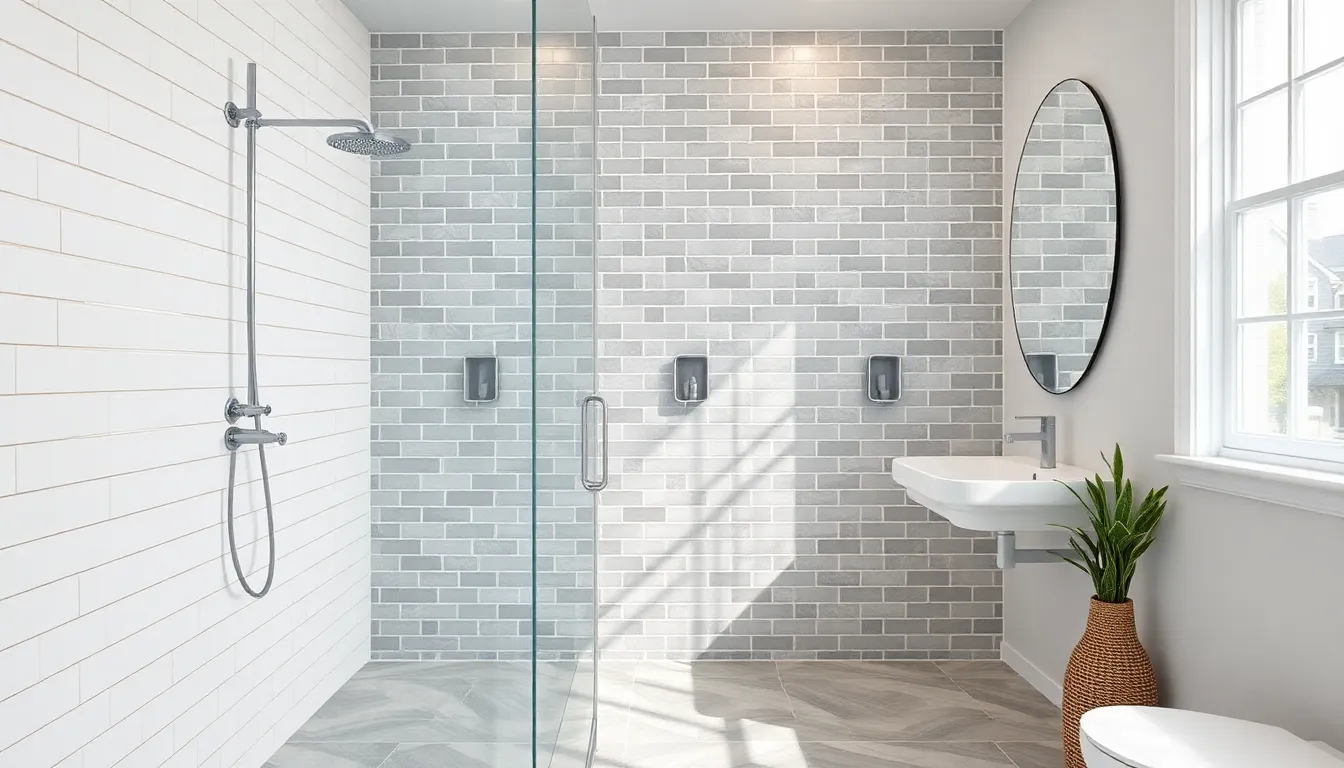
Creating a stunning shower doesn’t require very costly. We’ll explore affordable tile options that deliver impressive results without compromising on quality or style.
Ceramic Tile Cost-Effective Answers
Subway tiles remain the most popular choice for budget-conscious homeowners looking to maximize visual impact. These classic 3×6 inch ceramic pieces create an illusion of space in small bathrooms while maintaining timeless appeal. We recommend white ceramic subway tiles because they effectively hide soap scum and require minimal maintenance.
Large format tiles offer another cost-effective approach by minimizing grout lines for a seamless, high-end appearance. Installing 12×24 inch ceramic tiles reduces visual clutter and creates a more expensive look at a fraction of luxury tile costs. Porcelain varieties provide enhanced water resistance compared to standard ceramic options, making them ideal for shower environments.
Neutral ceramic colors like light gray and beige deliver versatile answers that complement various design styles. These shades reflect natural light effectively, making shower spaces appear larger and brighter. We’ve found that sticking to neutral palettes allows for easy updates through accessories and fixtures without replacing the entire tile installation.
DIY Installation Considerations
Surface preparation forms the foundation of successful tile installation and requires careful attention to detail. We recommend ensuring walls are completely level and clean before beginning any tile work. Proper waterproofing behind shower areas prevents costly moisture damage that could require complete reinstallation.
Essential tools include a notched trowel for spreading adhesive evenly and tile spacers for maintaining consistent grout lines. Quality tile cutters or wet saws become necessary for precise cuts around plumbing fixtures and corners. We suggest renting professional-grade equipment rather than purchasing tools you’ll use only once.
Safety measures protect both the installer and the final result during DIY projects. Wearing protective gloves prevents cuts from sharp tile edges, while safety goggles shield eyes from tile dust and adhesive splatter. Proper ventilation becomes crucial when working with tile adhesives and grouts that release potentially harmful fumes.
High-Impact Design on Limited Budget
Vertical patterns like stacked or herringbone layouts draw the eye upward, creating the illusion of higher ceilings. Installing subway tiles in a herringbone pattern transforms standard ceramic tiles into sophisticated focal points. We recommend this technique for accent walls where the pattern creates maximum visual impact without requiring extensive tile quantities.
Mosaic accent strips add visual interest through strategic placement without covering entire walls. Combining different ceramic colors and textures in narrow bands creates custom looks that rival expensive designer installations. These accent elements work particularly well around shower niches or as horizontal borders at eye level.
Strategic color placement maximizes the impact of limited tile budgets through careful planning. Using darker ceramic tiles on lower portions helps hide water spots and soap residue, while lighter shades above reflect light throughout the space. We suggest limiting bold colors to single accent walls to avoid overwhelming smaller shower areas while maintaining visual cohesion.
Specialty Tile Materials for Unique Bathrooms
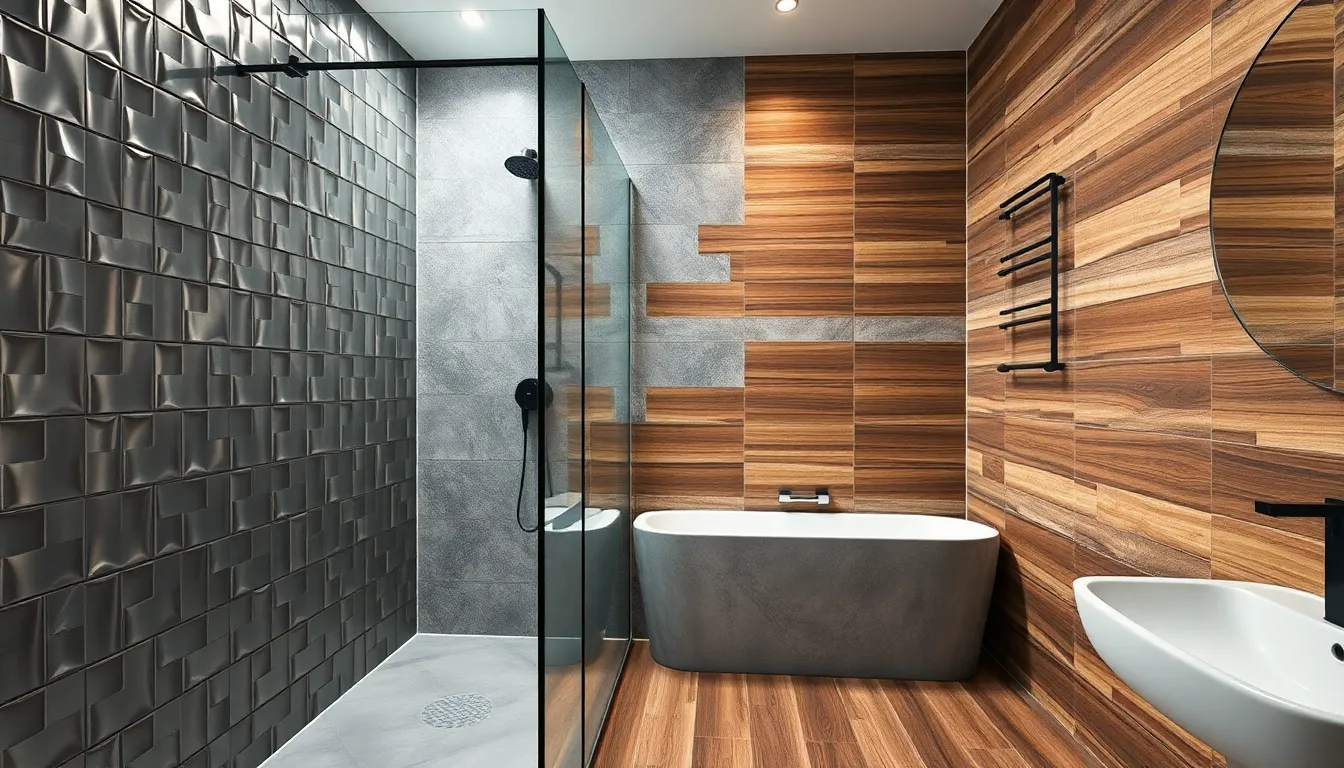
We’re exploring innovative tile materials that push creative boundaries beyond traditional ceramic and stone options. These specialty materials offer distinctive aesthetics that can transform your shower into a truly personalized space.
Metal Tiles for Industrial Aesthetic
Metal tiles deliver an industrial edge that complements modern bathroom designs with their sleek, contemporary appearance. Stainless steel options provide exceptional durability while creating striking reflective surfaces that amplify natural light throughout your shower space. Aluminum alternatives offer lightweight installation benefits and resist corrosion in moisture-rich environments.
Pairing metal tiles with contrasting materials like glass or natural stone creates ever-changing visual interest that elevates the overall design. These tiles work particularly well as accent walls or backsplashes, where their reflective properties can highlight architectural features. Installation requires specialized tools and techniques, but the resulting industrial sophistication justifies the additional effort.
Wood-Look Tiles for Warm Atmosphere
Wood-look tiles crafted from ceramic or porcelain materials provide the cozy warmth of natural wood without moisture-related concerns. These tiles successfully mimic authentic wood grain patterns and textures while maintaining the water resistance essential for shower environments. Rustic finishes create inviting atmospheres that transform sterile bathroom spaces into welcoming retreats.
Porcelain wood-look options offer superior durability compared to ceramic alternatives, making them ideal for high-traffic shower areas. Various plank sizes allow for creative installation patterns, from traditional straight layouts to contemporary herringbone designs. Color variations range from light oak tones to deep walnut shades, accommodating diverse design preferences.
Concrete-Style Tiles for Modern Edge
Concrete-style tiles bring industrial sophistication to contemporary shower designs through their authentic textured surfaces and neutral color palettes. Porcelain and ceramic versions replicate the appearance of poured concrete while providing superior water resistance and easier maintenance. These tiles feature subtle variations in texture and tone that create organic, lived-in aesthetics.
Large format concrete-style tiles minimize grout lines for seamless modern appearances that emphasize clean architectural lines. Their neutral gray tones serve as perfect backdrops for colorful accent pieces or metallic fixtures. Surface textures provide natural slip resistance, making them practical choices for shower floors and walls alike.
Design Tips for Small Shower Spaces
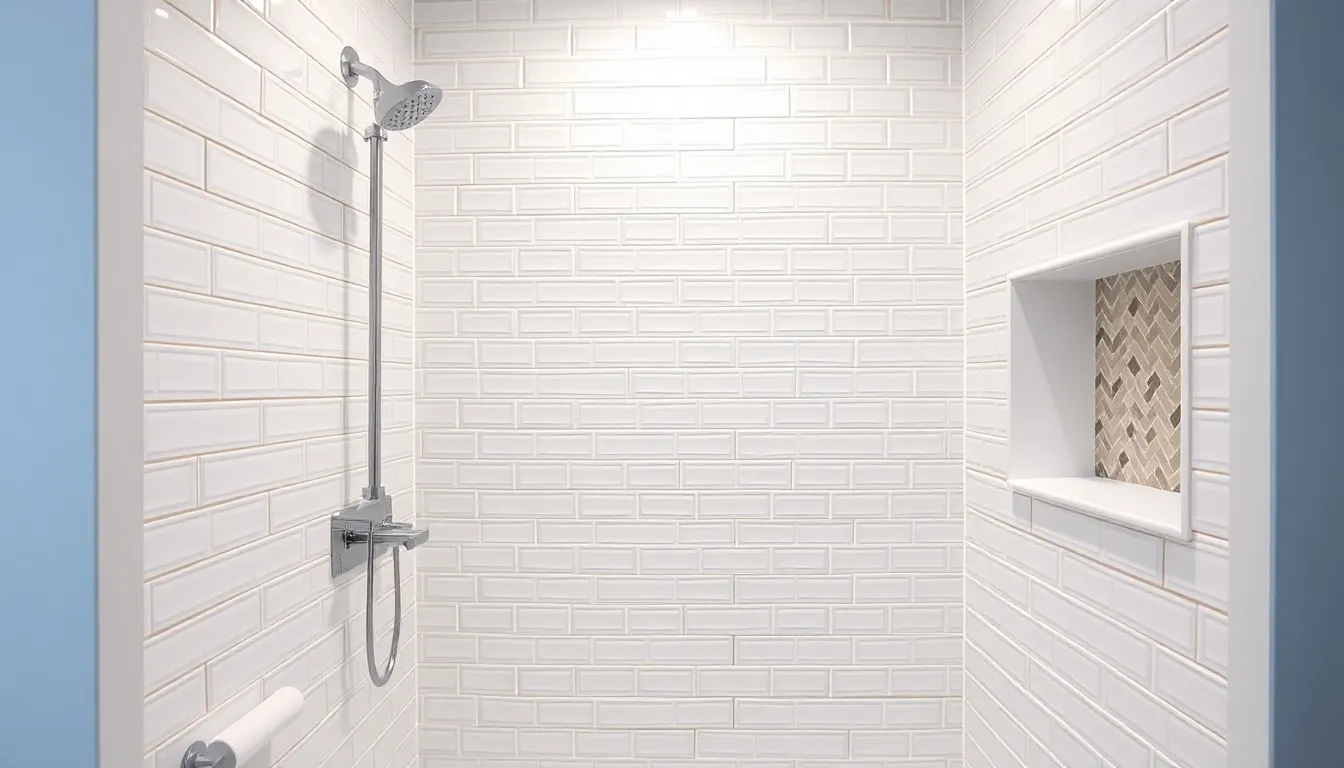
Creating the illusion of more space in compact shower areas requires strategic tile selection and smart design techniques. We’ll share proven methods that maximize both visual impact and functional benefits in smaller bathrooms.
Light Colors for Space Expansion
Light colored tiles serve as powerful tools for expanding visual space by reflecting natural and artificial light throughout the shower area. White tiles remain the most effective choice for creating brightness, as they bounce light off surfaces and eliminate visual boundaries that can make spaces feel cramped. Gray tiles offer a sophisticated alternative while maintaining the space expanding benefits, with lighter shades of gray providing the optimal balance between style and spatial perception.
Reflecting light becomes especially crucial in bathrooms without windows, where every surface contributes to the overall brightness level. Minimizing visual clutter through consistent light tones helps create seamless transitions between walls and reduces the choppy appearance that darker colors can create in confined spaces.
Vertical Tile Patterns for Height
Vertical subway tiles create dramatic height illusions by drawing the eye upward and emphasizing the shower’s vertical dimensions. Stacking these classic tiles vertically rather than horizontally transforms standard 8 foot ceilings into impressive focal points that feel more spacious and grand.
Herringbone patterns add sophisticated movement while maximizing the perception of vertical space through their angular geometry. Chevron patterns deliver similar height improving effects with their distinctive V shaped arrangement that guides visual flow upward. Both patterns contribute to openness by creating ever-changing surface textures that prevent walls from appearing flat or confined.
Installing tiles in vertical orientations works particularly well with rectangular formats, as the longer dimension emphasizes height when positioned vertically rather than horizontally.
Strategic Tile Placement Techniques
Accent walls transform small showers by using contrasting colors or bold patterns on single walls while keeping remaining surfaces neutral. This technique creates depth without overwhelming the space, allowing one dramatic element to serve as a focal point while other surfaces recede visually.
Shower niche tiles enhance harmony when they complement the surrounding tile palette rather than creating stark contrasts. Matching niche tiles to the main wall surface creates seamless integration, while subtle variations in finish or size add interest without disrupting visual flow.
Combining finishes through mixed glossy and matte surfaces provides both practical and aesthetic advantages in compact spaces. Glossy tiles reflect light and resist water spots, making them ideal for main wall areas, while matte finishes offer slip resistance for floors and accent areas. This combination maximizes both safety and visual appeal while addressing the exact challenges of small shower environments.
Conclusion
We’ve explored countless tile options that can transform your shower from ordinary to extraordinary. Whether you’re drawn to classic subway tiles or prefer the luxury of natural stone the right choice depends on your budget style preferences and maintenance requirements.
The key is balancing aesthetics with functionality. Large format tiles offer easy maintenance while textured surfaces provide safety without sacrificing visual appeal. For smaller spaces light colors and vertical patterns work wonders in creating the illusion of more room.
Remember that your shower tiles are an investment in both your daily comfort and your home’s value. Take time to consider how different materials colors and patterns will work together to create the bathroom oasis you’ve always wanted.
Frequently Asked Questions
What are the most popular shower tile styles for 2025?
Subway tiles remain the most popular choice due to their versatility and timeless appeal. Current trends include colored subway tiles in sage green and navy blue, large format tiles (12×24 inches or larger), and mosaic patterns combining glass, stone, and ceramic materials. Natural stone tiles like marble and travertine are also gaining popularity for their luxurious appearance.
How do I choose the right tile material for my shower?
Consider durability, maintenance, and budget. Ceramic tiles are affordable and easy to maintain, making them ideal for most bathrooms. Natural stone tiles like marble offer luxury but require more upkeep. Porcelain provides excellent water resistance and durability. Always ensure your chosen material has adequate slip resistance for safety.
What’s the best grout color for white subway tiles?
Dark grout creates striking visual contrast and is currently trending, especially in master bathrooms. However, white or light gray grout offers a classic, seamless look that’s easier to maintain. Dark grout shows less dirt but requires more careful cleaning, while light grout hides soap scum better.
Are large format tiles better than small tiles for showers?
Large format tiles (12×24 inches or larger) offer several advantages: they create a sophisticated, uninterrupted appearance, reduce visual clutter, and have fewer grout lines, making maintenance easier. They also minimize opportunities for mold and mildew accumulation. However, they may require professional installation and can be more expensive.
How can I make a small shower look bigger with tile choices?
Use light-colored tiles, especially white and light gray, to reflect light and expand visual space. Install tiles in vertical patterns like stacked subway or herringbone to enhance height perception. Consider glossy finishes to maximize light reflection, and use matching tiles in shower niches for seamless integration.
What are the benefits of textured shower tiles?
Textured tiles combine safety with aesthetic appeal. They provide better slip resistance, especially important for wet shower floors. Options include 3D wall tiles for visual depth, natural stone surfaces for tactile experience, and mixed texture combinations that create sophisticated layering effects while engaging multiple senses.
Should I use the same tiles on shower walls and floors?
Not necessarily. While matching creates a cohesive look, you can use different tiles for functionality. Floor tiles should prioritize slip resistance with textured or smaller mosaic options, while wall tiles can focus on aesthetics. Many designers recommend using complementary materials or patterns to create visual interest.
What’s the average cost difference between ceramic and natural stone tiles?
Ceramic tiles are the most budget-friendly option, typically costing significantly less than natural stone. Natural stone tiles like marble and travertine have higher material and installation costs but offer increased home value and luxury appeal. The investment often pays off in both aesthetics and property value.
How do I maintain different types of shower tiles?
Ceramic and porcelain tiles require minimal maintenance with regular cleaning. Natural stone tiles need periodic sealing and specialized cleaners to prevent staining. Glass mosaic tiles show water spots easily but clean well with regular maintenance. Textured tiles may require more thorough cleaning to remove buildup in crevices.
Can I install shower tiles myself or should I hire a professional?
Simple ceramic subway tiles can be DIY-friendly for experienced homeowners. However, complex patterns like herringbone, large format tiles, natural stone, and intricate mosaics typically require professional installation to ensure proper waterproofing, alignment, and longevity. Poor installation can lead to costly water damage and repairs.

